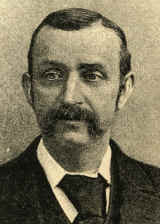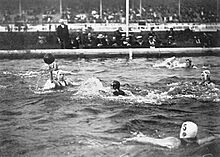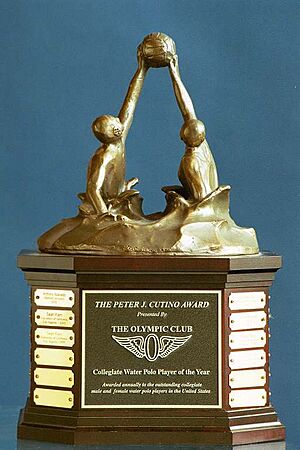History of water polo facts for kids
The history of water polo as a team sport began in the mid-1800s in England and Scotland. Back then, water sports were popular at local fairs and festivals.
Contents
How Water Polo Began
The first rules for water polo were created in Great Britain by William Wilson. He was a Scottish journalist, swimming teacher, and coach. Wilson also wrote The Swimming Instructor, one of the first books about swimming. He invented the game while working at the Arlington Baths Club.
The game started as a type of rugby football played in rivers and lakes in England and Scotland. Players used a ball made of Indian rubber. This "water rugby" became known as "water polo." The name likely came from the English way of saying "pulu," a word from the Balti language (spoken in Kashmir) that means "ball."
In the early days, the game was very physical. Players could use brute strength, wrestle, and even hold opponents underwater to get the ball. The goalie stood outside the playing area. They would jump in only when an opponent tried to score by placing the ball on the deck.
In 1870, a group called the London Swimming Association decided to create rules for "football in the water." This shows that different versions of the sport existed before it was commonly called "water polo." Other names included "water base ball" and "aquatic football."
One of the first recorded games called "water polo" happened at the Crystal Palace in London on September 15, 1873. It was part of a big outdoor festival held by the London Swimming Club.
The modern game also grew in Scotland in the late 1800s. The first water polo games were played at the Arlington Baths Club in Glasgow. In 1886, the Scottish Amateur Swimming Association held its first championship, the West Cup. This was likely the first club tournament in the world, and it is still played today.
The Swimming Association of Great Britain officially recognized the sport in 1885. Canada was one of the first countries outside the United Kingdom to start playing water polo. The Midland Counties Swimming and Aquatic Football Association in England probably set up the world's first water polo league in 1884.
The first national club championships in England were held in 1888. The London Water Polo League was formed in 1889. The longest-running single match is the yearly game between Oxford and Cambridge universities. Their first match was played in 1891.
The first international water polo match was between England and Scotland in London on July 28, 1890. Scotland won 4–0. Two important figures, William Henry and Archibald Sinclair, later wrote a book called Swimming in 1893. It included a chapter on water polo, which might be the first book to do so.
Water Polo Around the World
By the 1880s, the game focused more on swimming, passing, and shooting into a goal net. Players could only be tackled when they had the ball and could not be held underwater. Canada was one of the first countries outside Britain to adopt the sport. The Montreal Swimming Club formed a water polo team in 1887.
In 1888, an English swimming instructor named John Robinson brought the sport to the USA. He started a team at the Boston Athletic Association. The first US championships were held in 1890.
Between 1890 and 1900, the game spread across Europe. Countries like Hungary, Belgium, Austria, Germany, and France started playing using British rules. However, a different, rougher game was played in the United States. It involved holding, diving underwater, and using a soft, semi-inflated ball that could be gripped tightly.
In 1900, water polo became the first team sport added to the Olympic Games. Because of the different rules, European and American teams did not compete against each other at first. By 1914, most US teams agreed to follow international rules. An international water polo committee was formed in 1929. The FINA (International Amateur Swimming Federation) has been the main international governing body for the sport since 1930.
Over the years, changes were made to the game's techniques and rules. In 1928, Hungarian coach Béla Komjádi invented the "air pass" or "dry pass." This is when a player passes the ball directly through the air to another player, who catches it before it hits the water. Before this, players would let the ball drop into the water first. The dry pass made the game faster and helped Hungary become a dominant force in water polo for 60 years.
In 1936, James R. ("Jimmy") Smith developed a new water polo ball with an inflatable bladder and a rubber fabric cover. This was a big improvement because the old leather balls would soak up water and get heavier during the game.
Later rule changes also sped up the game. In 1949, play could continue after a referee whistled a minor foul. In the 1970s, a new rule called the "exclusion foul" was introduced. Players who committed a major foul were sent out of the game for one minute, making their team play with fewer players. Also, teams were given a limited time (45 seconds at first) to try and score. These time limits have been reduced since then.
Local Rule Differences
United States Rules
In 2006, some rules in the United States were updated. The four and seven-meter lines were combined into a five-meter line. Under these rules, a goalkeeper can use two hands and stand on the bottom of the pool (if it's shallow) until the 5-meter line. They can go beyond the 5-meter line following field rules (one hand on the ball, no standing). Goalies can also hit the ball with a closed fist, though this is not usually recommended.
New cap rules were also put in place. A goalie's cap must now have alternating red and dark colors for home games, and red and white for away games. The goalie must wear number 1 or 13. For women, a red swim cap must be worn under the goalie cap.
Water Polo at the Olympics
Men's water polo was one of the first team sports introduced at the 1900 Paris Olympic Games. Women's water polo became an Olympic sport at the 2000 Sydney Olympic Games. This happened after protests from the Australian women's team. Australia then won the gold medal in a thrilling final against the United States.
Some of the greatest water polo players have competed in the Olympics. Spain's Manuel Estiarte played in a record six Olympics. Dezső Gyarmati of Hungary won water polo medals at five Olympics in a row (three golds, one silver, one bronze). Tamás Faragó also led Hungary to Olympic medals. American Terry Schroeder helped the United States win its first Olympic silver medals in 1984 and 1988.
One of the most famous water polo matches in history is the "Blood In The Water" game. This was the semi-final match between Hungary and the Soviet Union at the 1956 Summer Olympics. As the athletes traveled to the games, the Hungarian revolution began, and the Soviet army stopped the uprising. Many Hungarian athletes felt they could only fight back by winning in the pool.
The game was very intense. The Hungarians defeated the Soviets 4–0. The game was stopped in the final minute to prevent angry Hungarian fans from reacting to a Soviet player punching Ervin Zádor in the eye. The Hungarians went on to win the Olympic gold medal. A documentary called Freedom's Fury tells the story of this game and the Hungarian uprising.
International Competitions
Since 1973, a men's Water Polo World Championship has been held every 2 to 4 years, along with the World Swimming Championship. Women's water polo was added in 1986. Another tournament, the FINA Water Polo World Cup, has been held every other year since 1979. In 2002, FINA started the FINA Water Polo World League, where the best national teams compete each year.
The annual Varsity Match between Oxford and Cambridge Universities is the sport's longest running rivalry, first played in 1891.
Major International Results
Olympic Games
Hungary has been the most successful country in men's Olympic water polo. The United States is the only team to win multiple times in the women's tournament since it started.
World Aquatics Championships
Italy has been the most successful country in men's World Championships, and the United States in women's.
FINA Water Polo World Cup
Hungary has won the most men's World Cups, and the Netherlands the most women's.
FINA Water Polo World League
Serbia has been the most successful country in the men's World League, and the United States in the women's.
Water Polo in US Colleges and Clubs
Today, club water polo is becoming more popular in the United States. Most club teams are in California, Florida, Illinois, and Texas. However, high schools in New England and Missouri also often have teams. US club teams compete in national championships like Junior Olympics and the Speedo Cup.
Many international players are now joining US college women's water polo teams. This is because water polo is popular globally, and American colleges offer great opportunities. For example, the 2005 Hawaii women's water polo team had nine international players.
Teams from California are very strong at the college level. Many water polo players in the United States also have strong academic backgrounds. For instance, former USA team captain Wolf Wigo and Olympic goalie Jacqueline Frank DeLuca both attended Stanford University. Omar Amr played on the US National Team while studying at Harvard Medical School.
College Championships
In the 2008 NCAA Women's Water Polo Championship, the UCLA women's team won their fourth championship in a row. In the 2007 Men's NCAA Finals, the UC Berkeley Golden Bears won their second title in a row.
The most important individual award in US college water polo is the Peter J. Cutino Award. It was created in 1999 and is given each year to the top American male and female college water polo players.
See also
- Dimitrios Diathessopoulos, known as the father of Greek water polo.
- Glossary of Water Polo
- Rules of water polo





